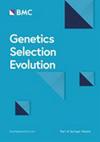Micro-genetic environmental sensitivity across macro-environments of chickens reared in Burkina Faso and France
IF 3.6
1区 农林科学
Q1 AGRICULTURE, DAIRY & ANIMAL SCIENCE
引用次数: 0
Abstract
Commercial poultry production systems follow a pyramidal structure with a nucleus of purebred animals under controlled conditions at the top and crossbred animals under commercial production conditions at the bottom. Genetic correlations between the same phenotypes on nucleus and production animals can therefore be influenced by differences both in purebred-crossbred genotypes and in genotype-by-environment interactions across the two environments, known as macro-genetic environmental sensitivity (GES). Within each environment, genotype-by-environment interactions can also occur due to so-called micro-GES. Micro-GES causes heritable variation in phenotypes and decreases uniformity. In this study, genetic variances of body weight (BW) and of micro-GES of BW and the impacts of purebred-crossbred differences and macro-environmental differences on micro-GES of BW were estimated. The dataset contained three subpopulations of slow-growing broiler chickens: purebred chickens (PB) reared in France, and crossbred chickens reared in France (FR) under the same conditions as PB or reared in Burkina Faso (BF) under local conditions. The crossbred chickens were offspring of the same dam line and had PB as their sire line. Estimates of heritability of BW and micro-GES of BW were 0.54 (SE of 0.02) and 0.06 (0.01), 0.67 (0.03) and 0.03 (0.01), and 0.68 (0.04) and 0.02 (0.01) for the BF, FR, and PB subpopulations, respectively. Estimates of the genetic correlations for BW between the three subpopulations were moderately positive (0.37 to 0.53) and those for micro-GES were weakly to moderately positive (0.01 to 0.44). The results show that the heritability of the micro-GES of BW varies with macro-environment, which indicates that responses to selection are expected to differ between macro-environments. The weak to moderate positive genetic correlations between subpopulations indicate that both macro-environmental differences and purebred-crossbred differences can cause re-ranking of sires based on their estimated breeding values for micro-GES of BW. Thus, the sire that produces the most variable progeny in one macro-environment may not be the one that produces the most variable offspring in another. Similarly, the sire that produces the most variable purebred progeny may not produce the most variable crossbred progeny. The results highlight the need for investigating micro-GES for all subpopulations included in the selection scheme, to ensure optimal genetic gain in all subpopulations.在布基纳法索和法国饲养的鸡在宏观环境中的微遗传环境敏感性
商业家禽生产系统遵循金字塔结构,上层是控制条件下的纯种动物,下层是商业生产条件下的杂交动物。因此,核动物和生产动物上相同表型之间的遗传相关性可能受到纯种杂交基因型差异和两种环境中基因型与环境相互作用差异的影响,即宏观遗传环境敏感性(GES)。在每个环境中,基因型与环境的相互作用也可能由于所谓的微ges而发生。微ges引起表型遗传变异,降低均匀性。本研究估计了体重和体重微ges的遗传变异,以及纯种杂交差异和宏观环境差异对体重微ges的影响。该数据集包含生长缓慢的肉鸡的三个亚群:在法国饲养的纯种鸡(PB),以及在与PB相同条件下在法国饲养的杂交鸡(FR)或在当地条件下在布基纳法索饲养的杂交鸡(BF)。杂交鸡是同一母系的后代,其父系为PB。BF、FR和PB亚群的体重和微体重遗传力分别为0.54 (SE为0.02)和0.06(0.01),0.67(0.03)和0.03(0.01),0.68(0.04)和0.02(0.01)。3个亚群体重的遗传相关性为中正相关(0.37 ~ 0.53),微体重的遗传相关性为中正相关(0.01 ~ 0.44)。结果表明,不同宏观环境下,BW的微观遗传力存在差异,表明不同宏观环境下对选择的响应存在差异。亚群体间的弱至中度正遗传相关表明,宏观环境差异和纯种杂交差异都可能导致种群根据其估计的体重微ges繁殖值重新排序。因此,在一种宏观环境中产生最多变异后代的父系,在另一种宏观环境中产生最多变异后代的父系,可能就不是这样了。同样,产生最多变异的纯种后代的父系可能不会产生最多变异的杂交后代。研究结果表明,有必要对纳入选择方案的所有亚群进行微观遗传变异研究,以确保在所有亚群中获得最佳遗传增益。
本文章由计算机程序翻译,如有差异,请以英文原文为准。
求助全文
约1分钟内获得全文
求助全文
来源期刊

Genetics Selection Evolution
生物-奶制品与动物科学
CiteScore
6.50
自引率
9.80%
发文量
74
审稿时长
1 months
期刊介绍:
Genetics Selection Evolution invites basic, applied and methodological content that will aid the current understanding and the utilization of genetic variability in domestic animal species. Although the focus is on domestic animal species, research on other species is invited if it contributes to the understanding of the use of genetic variability in domestic animals. Genetics Selection Evolution publishes results from all levels of study, from the gene to the quantitative trait, from the individual to the population, the breed or the species. Contributions concerning both the biological approach, from molecular genetics to quantitative genetics, as well as the mathematical approach, from population genetics to statistics, are welcome. Specific areas of interest include but are not limited to: gene and QTL identification, mapping and characterization, analysis of new phenotypes, high-throughput SNP data analysis, functional genomics, cytogenetics, genetic diversity of populations and breeds, genetic evaluation, applied and experimental selection, genomic selection, selection efficiency, and statistical methodology for the genetic analysis of phenotypes with quantitative and mixed inheritance.
 求助内容:
求助内容: 应助结果提醒方式:
应助结果提醒方式:


